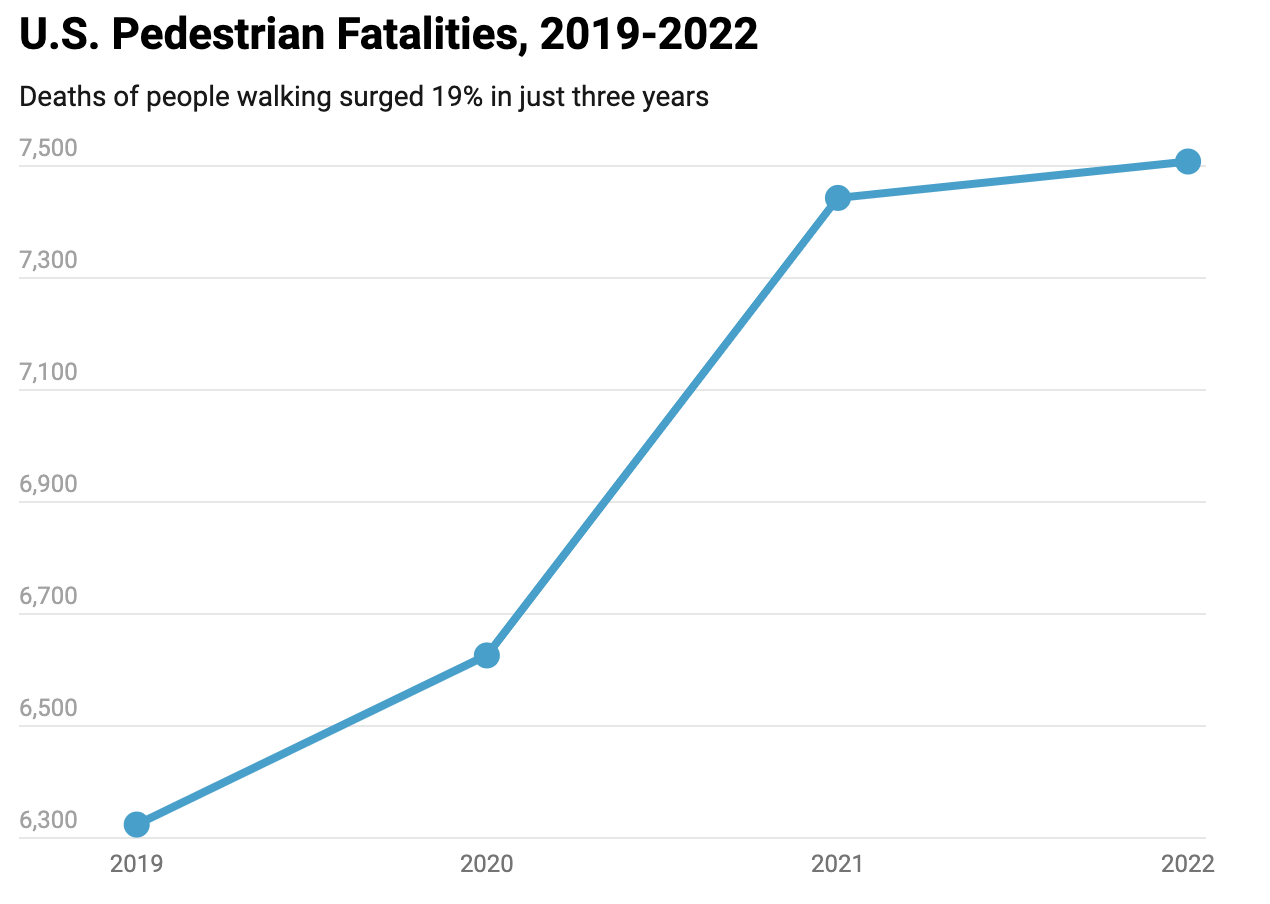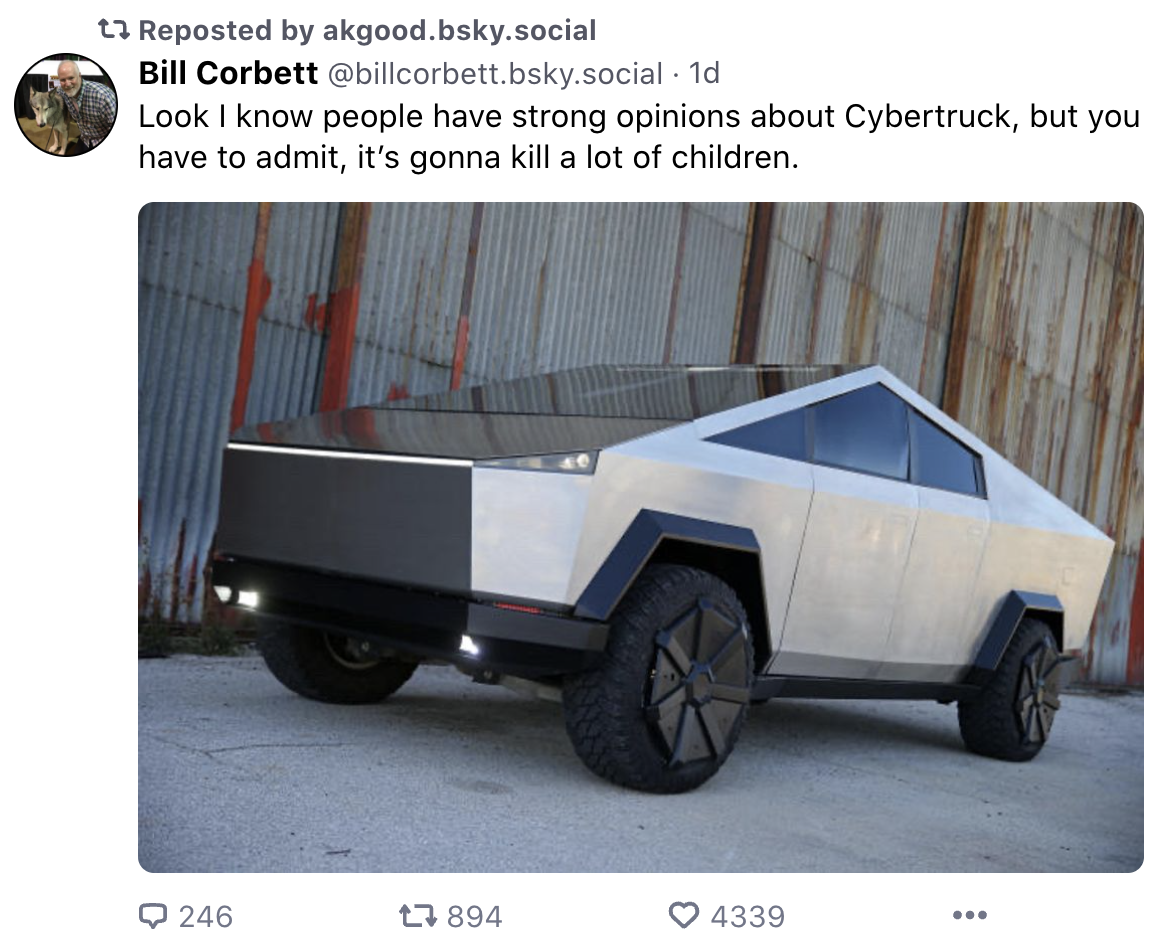On Curbing Pedestrian Deaths
In which an excellent op-ed by Jamelle Bouie prompts me to stake out my current baseline position in the War on Cars.

It's no secret that streets have gotten less and less safe for pedestrians over the last decade or more—20 pedestrians killed by cars every day in 2022, and the rate keeps climbing. Well, I say cars but the reality of the situation is that it isn't "cars" so much as the massive proliferation of large SUVs and trucks over that same time period. As Jamelle Bouie puts it in a NYT article "The Path to Reducing Pedestrian Deaths is Steep but Straight":
These vehicles, which often dwarf the size of their predecessors, are harder to control and have large blind zones in the front or rear, making them much more difficult to operate in busy or crowded areas.
It turns out that due to the difficulty of control and large blind spots, these vehicles make it easier to hit people. Once that happens, physics takes over—in the past, with a traditional car, the struck pedestrian (or cyclist!) is most likely to end up atop the hood—the strike point is the legs. With these large vehicles, the strike point is the substantially more dangerous-to-life torso, and the struck victim is more likely to end up in the crumple zone or under the vehicle.
Lots of articles—including Bouie's very good one!—implicate vehicle weight. But it turns out the extra mass reaches a point of diminishing returns rapidly when it comes to assessing pedestrian lethality [[1]]. As this extremely detailed breakdown of the physics summarizes:
Does increasing the mass of a car make it more likely for pedestrians to be killed? No! Increasing front end height does though.

It's all about the impulse transfer and where a victim who gets hit ends up. These big vehicles are simply not safe in a world of increasingly-distracted drivers. So, what do we do about it? Well, as Bouie points out—it's a pretty straight line, but won't necessarily be an easy one to walk.
There are three avenues of approach, none probably sufficient on it's own: regulation, enforcement, and urban planning. The planning approach involves investing in street and sidewalk infrastructure to slow traffic down, referred to as "Traffic Calming". Cities can also make investments in transit infrastructure to increase access to car-trip alternatives. Enforcement would probably entail deploying more cameras and increased penalties for distracted and dangerous driving. I'm not as familiar with that literature, but Bouie's article links some research on the topic. Both of these approaches will entail battles at the local political level against proponents of the car-centric status quo armed with the usual arguments: "we need to study this more" and "the traffic must flow as fast as possible, ideally through other people's neighborhoods, because the character of my neighborhood is as important as my five minute commute to Costco in my F150".[[2]] "I'm a cyclist too, but the streets are so dangerous we just need to give up on requiring cars to share the road—it's more or less your fault for being near one not in a big car" is an argument I have heard a lot. It sure feels defeatist.
Transit infrastructure in the United States is also subject to a vicious case of cost disease, about which much digital ink has been spilled but the origins of which remain at least somewhat mysterious. There's renewed focus on the permitting process (see above about delaying tactics from motivated groups in local munis) but also I don't think we can discount the cost of America's obsession with consultants. About which I'll have to find time to soapbox later. It's a fascinating and important line of research.
Regulation seems to me to be the furthest away from realization, but also like a very potent tool. Rather than putting my eggs in a "taxing weight" basket, I'd prefer to regulate size—particularly front-end size—and add rules about sight lines and blind spots to a vehicle's safety rating; in essence making safety for pedestrians and other people on the road part of the vehicle's overall safety rating. Large vehicles ought to require an additional rider on one's license, to reduce the number of people buying them as status items without having any training in operating them.
It feels like there's a "personal responsibility" angle here as well—I don't have comprehensive data on this[[3]] but man, post-COVID, it feels like the roads are full of drivers who simply lack situational awareness; whether we're all hyper-focused on our own business, driving angry, or exhibiting a higher baseline misanthropy I don't know, but we could all—myself included—do a better job being more attentive and chill out there. Drive with a bit of grace, if you will.
[[1]]: it does matter when two cars—which have weights closer to the same order of magnitude—collide.
[[2]]: my own city is currently trying to expedite more traffic calming measures, but first we must deal with "good faith" arguments that we need more data or that, I dunno, apparently neighborhoods near proposed calming measures need to be able to reject them on a majority vote.
[[3]]: though that chart at the head of the article is suggestive!
Comments ()